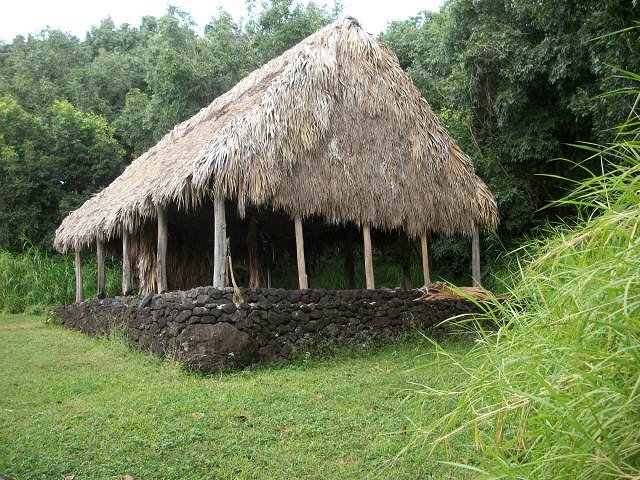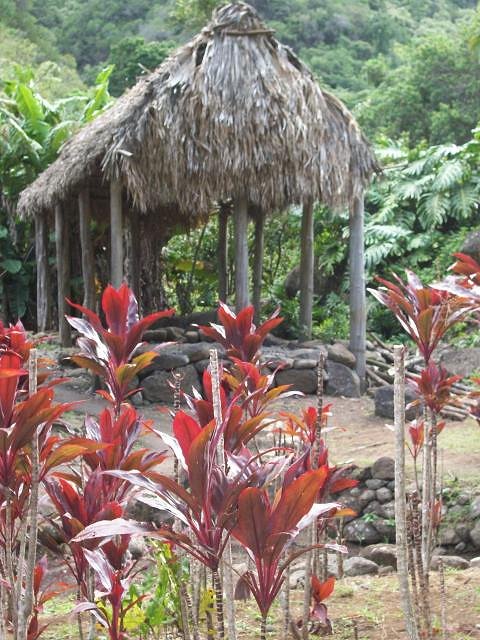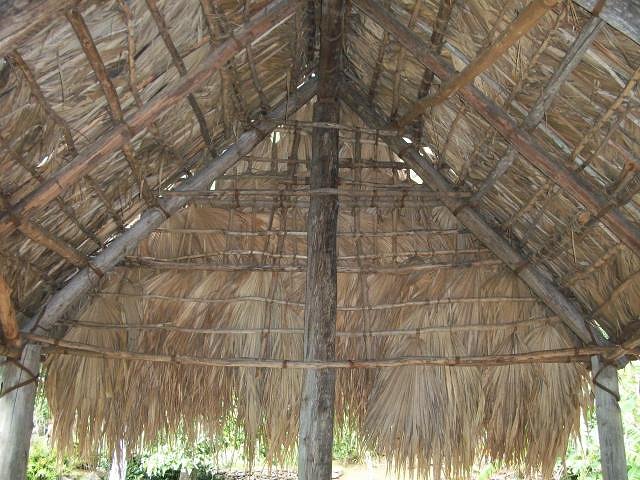Beyond Tiki, Bilge, and Test / Beyond Tiki
NY TIMES Article about a Hale Builder in Hana
Pages: 1 1 replies
|
TC
Tiki Chris
Posted
posted
on
Tue, Oct 22, 2002 3:17 PM
NY Times ANA, Hawaii, Oct. 19 — The trade winds have begun to blow, softly riffling the palm thatching overhead. In Hana Bay below, the floats of the fishermen's nets bob in the gentle surf, but the akule fish have gone to deeper water for the day. The dugout canoes lie idle on the rocks, for the men will not be pulling their nets tonight. Advertisement This is the old Hawaii, the idyll that Francis Sinenci hopes to recapture for another generation. Here on the isolated east coast of Maui, he and a handful of others are trying to revive the dying art of the building of the thatched Hawaiian hut known as the hale (pronounced HAH-lay). The fishermen spend their free hours in an open-sided thatched-roof shack known as a kilo'ia hale that Mr. Sinenci built above the beach. They eat fruit, drink beer and watch the water for the faint changes in color and wave pattern brought by a school of feeding akule, a type of mackerel. A few dozen such structures dot the islands, many of them built by Mr. Sinenci, 60, a former Air Force mechanic of Hawaiian and Philippine ancestry who returned to his hometown, Hana, to enjoy his retirement and build hales. Until now, however, county building codes have frustrated him. It is easier to get a permit to slap together a house of plywood and milled framing lumber from the mainland than it is to get government approval to construct what he considers a work of art using native materials. The Maui County Council, working with the Indigenous Architecture Task Force, for which Mr. Sinenci is a consultant, recently approved new building codes that will permit construction of more grass huts. They can be used for public gatherings like luaus or church meetings, storage of seagoing canoes, sleeping and roadside stands. If the hale stands near an occupied structure, the roof must be fitted with a sprinkler system for fire safety. Hale-building is painstaking and time-consuming, taking as long as six months. The first step is to head out into the interior forests to search for suitable trees for the support pillars and crossbeams. The favored wood is native ohia, but there is little left on islands, so hale builders generally use ironwood and eucalyptus. When Mr. Sinenci and his crew find trees sufficiently tall and straight, he hauls a chain saw from his Ford Explorer and hacks away. No machete or two-handled saw? No horse-drawn sled to drag the timber? "Are you kidding?" Mr. Sinenci says. "I want to finish this century." The logs are then stripped of bark and dried in the sun. Next comes weeks of what Mr. Sinenci calls "marinating," soaking the logs in the ocean as a natural treatment against termites and other insects. The wood is dried again and the vertical pieces are sunk into the ground, sometimes with the aid of mortar, another nonnative concession to modernity. The beams and purlins, the narrow strips that hold the roofing material, are lashed together, usually with nylon cord. Earlier generations used sennit grass or pulled the fiber from the shells of coconuts and wove them into rope. Meantime, the builders return to the forests to gather material for thatching. Traditional Hawaiian huts were roofed with pili grass, but that, too, is in short supply, so the favored material now is the fan palm, whose leaves can grow as wide as six feet. The palm branches are lashed thickly to the roof beams, creating a four-inch-thick roof that is impervious to rain, and, Mr. Sinenci swears, is hurricane-proof. "The wind gets up under the leaves and dissipates," he said, "just like radar beams on a stealth aircraft. You have to bend with the wind to survive a hurricane. Those asphalt shingles just fly right off." Hans Riecke, a retired architect who is a member of the indigenous architecture task force, says it remains to be seen how great the demand will be for grass huts on the islands and how many people will try to build them. "People have no idea what's involved," Mr. Riecke said. "It's a very intricate process." Maui Community College is preparing to offer a course in hale-building under its continuing education program. It hopes the craft will attract young people who are looking for a way to make a living on the islands, said Sharane Gomes, training coordinator for the college. The college has been designated as the certifying agency for potential hale builders. Mr. Sinenci will be among the teachers. "There's already a waiting list for people who want to get into the program," Ms. Gomes said. Also, it seems, a waiting list for buyers. John Romain, proprietor of a collection of seaside guest cottages known as Hana Hale Malamalama (which means "light" or "knowledge"), says the hale symbolizes peacefulness and the true spirit of Hawaii. "Nothing feels better than to sit in one of Francis's grass-roofed hales and just enjoy the time," he said. |
|
S
skootiki
Posted
posted
on
Sun, Jan 17, 2010 10:23 AM
although this is a pretty old thread, I thought that these photos from a recent trip to Maui might fit here
|
Pages: 1 1 replies



